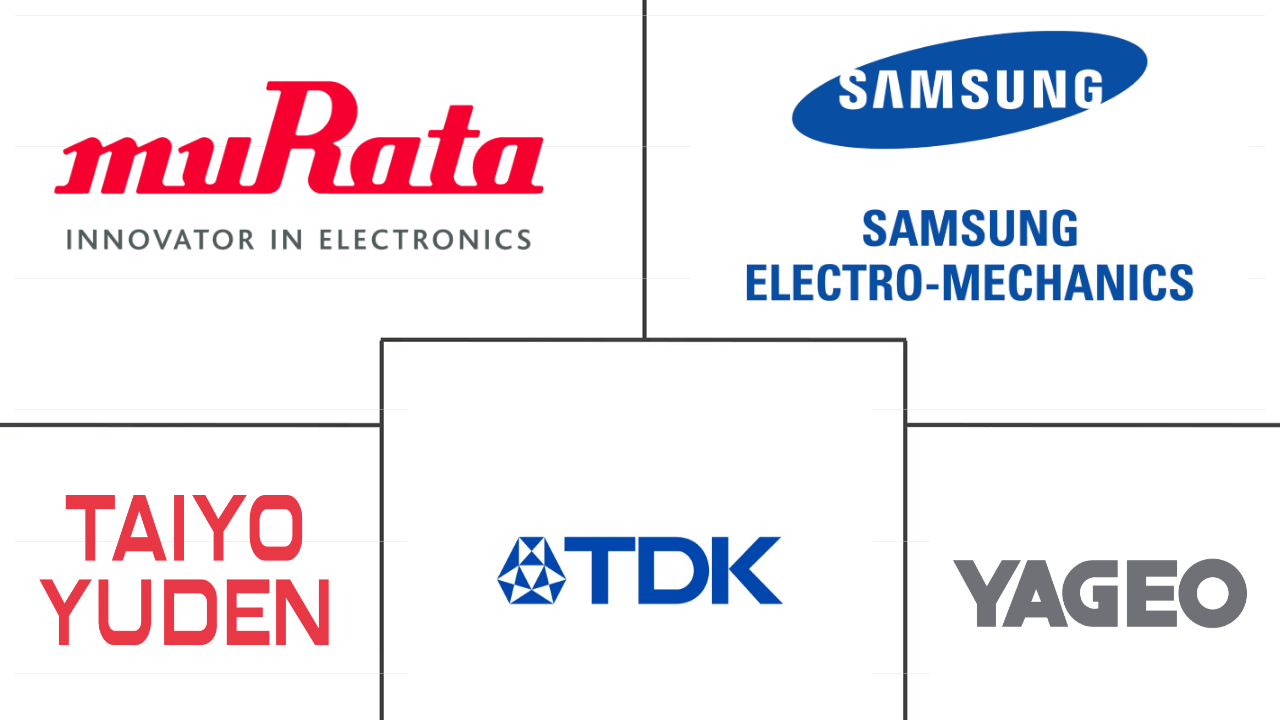Multilayer Ceramic Capacitor (MLCC) Market Size and Share
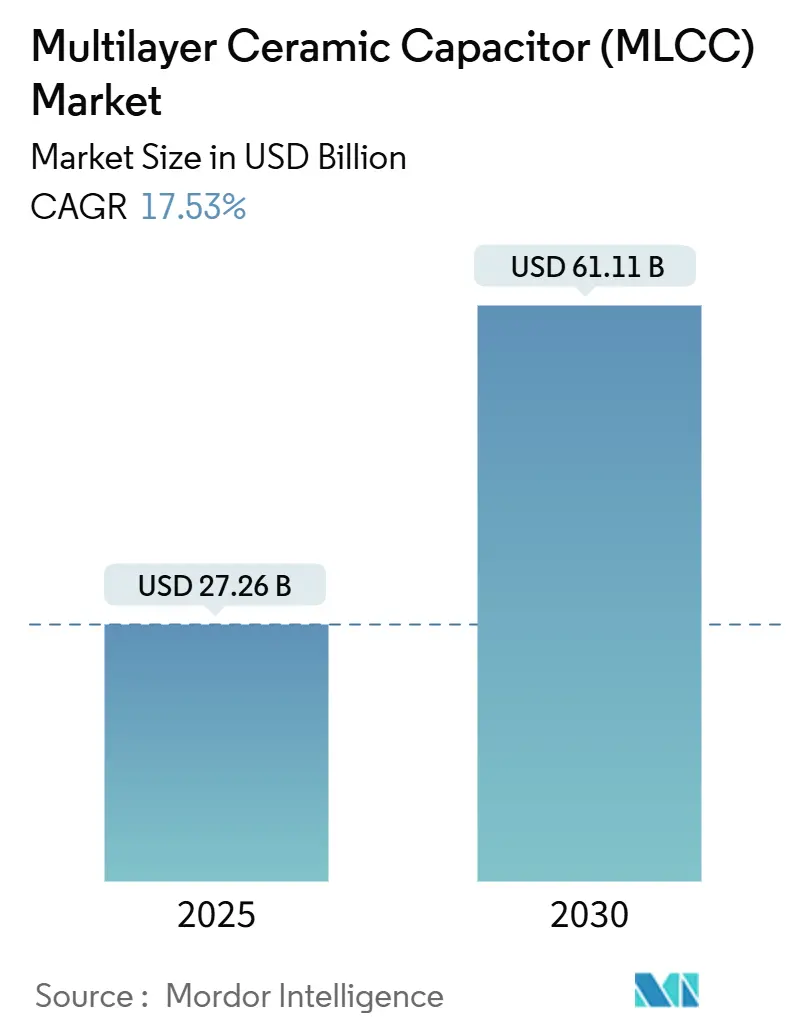
Multilayer Ceramic Capacitor (MLCC) Market Analysis by Mordor Intelligence
The multilayer ceramic capacitor market size reached USD 27.25 billion in 2025 and is projected to climb to USD 61.12 billion by 2030, reflecting a 17.53% CAGR over the forecast period. Robust demand from electric vehicles, 5G infrastructure, and AI servers offsets lingering supply-demand imbalances that began in 2018. Precision dielectrics, miniaturization breakthroughs, and rising high-voltage requirements continue to steer product innovation. At the same time, raw-material price swings and capacity bottlenecks constrain near-term output even as on-shore manufacturing initiatives in the United States and Europe gather pace. Competitive dynamics remain shaped by a handful of Japanese leaders that protect their intellectual property and equipment ecosystems, leaving price-sensitive volume pockets for rapidly scaling Chinese suppliers.
Key Report Takeaways
- By dielectric type, Class 1 products led with 62.70% revenue share in 2024; Class 1 formulations are advancing at a 18.92% CAGR through 2030.
- By case size, the 201 case size segment held 56.48% of market share in 2024, while the 402 case size segment is advancing at a 18.66% CAGR through 2030.
- By voltage rating, the low-range voltage rating led with 59.34% revenue share in 2024, while the mid-range voltage rating is advancing at an 17.55% CAGR through 2030.
- By mounting type, surface-mount type led with 41.70% revenue share in 2024, while metal-cap type is advancing at a 18.34% CAGR through 2030.
- By end user, consumer electronics held 51.46% of the multilayer ceramic capacitor market share in 2024, while automotive applications are expanding at an 30.06% CAGR to 2030.
- By geography, Asia-Pacific accounted for 57.69% of the multilayer ceramic capacitor market size in 2024 and the North America is projected to post an 19.53% CAGR between 2025-2030.
Global Multilayer Ceramic Capacitor (MLCC) Market Trends and Insights
Drivers Impact Analysis
| Driver | (~) % Impact on CAGR Forecast | Geographic Relevance | Impact Timeline |
|---|---|---|---|
| Surge in 5G smartphone and consumer-electronics MLCC density | +1.80% | Global, with APAC leading adoption | Medium term (2-4 years) |
| Electrification and ADAS boost MLCC/vehicle content | +2.10% | Global, with Europe and China leading EV adoption | Long term (≥ 4 years) |
| AI-server decoupling demand for high-CV MLCCs | +1.20% | North America and APAC data center hubs | Short term (≤ 2 years) |
| Explosive growth in IoT nodes and mini-devices | +0.90% | Global, with strong growth in MEA and Latin America | Medium term (2-4 years) |
| Chiplet/heterogeneous-package MLCC integration | +0.70% | North America and APAC semiconductor hubs | Long term (≥ 4 years) |
| EU/US Chips-Act incentives for on-shore MLCC lines | +0.40% | North America and Europe | Long term (≥ 4 years) |
| Source: Mordor Intelligence | |||
Surge in 5G smartphone and consumer-electronics MLCC density
Each 5G handset now integrates 1,000-1,500 MLCCs compared with 800-1,000 in 4G models. Samsung Electro-Mechanics introduced an AEC-Q200 certified 2.2 µF, 10 V component in a 1005 package that satisfies LiDAR module voltage headroom while preserving slim profiles.[1]Samsung Electro-Mechanics, “High-Reliability MLCC for LiDAR,” samsung.com Rapid base-station rollouts call for low-loss, millimeter-wave-ready MLCCs, and smartphone OEMs increasingly adopt three-socket ultra-slim parts that trim board thickness by 18%. The upshot is steady unit growth and higher average capacitance per device, lifting value share for Class 2 dielectrics across consumer and telecom designs.
Electrification and ADAS boost MLCC/vehicle content
A battery-electric vehicle employs roughly 22,000 MLCCs, or three-to-seven times the count in a conventional car. In January 2025, TDK unveiled a 10 nF, 1,250 V C0G MLCC in 3225 size, built for SiC-based traction inverters.[2]TDK Corporation, “MLCCs with 10 nF and C0G Characteristics at 1,250 V in 3225 Size,” tdk.com OEM migration to 800 V architectures raises voltage ratings even for cabin electronics, while autonomous driving stacks tighten reliability thresholds. Murata’s greenfield expansion in Tamil Nadu and TDK’s Kitakami line ramp underscore the push for automotive-grade capacity that can pass AEC-Q200 stress cycles and deliver consistent supply to Tier 1s.
AI-server decoupling demand for high-CV MLCCs
Latest GPU accelerators require 100-500 µF of distributed capacitance to tame power-rail transients. Kyocera reached 10 µF in an EIA 0201 package, freeing board area on densely packed AI accelerator cards.[3]Kyocera Corporation, “10 µF MLCC in EIA 0201 Package,” kyocera.com Chiplet-based CPUs and GPUs disperse voltage domains across substrates, catalyzing local MLCC banks with ultra-low ESR. Cloud operators, therefore, specify high-capacitance, low-inductance arrays that shrink count and improve transient response, a sweet spot for Class 2 X7R parts optimized for 100 V ratings.
Explosive growth in IoT nodes and mini-devices
Global IoT deployments add billions of low-power sensors, wearables, and edge controllers that mandate miniature MLCCs with minimal leakage. Middle East and Africa municipalities adopt smart-city platforms, propelling regional volume growth. Battery-operated nodes favor Class 1 C0G/NP0 parts for thermal stability, yet volumetric efficiency keeps Class 2 dominant in cost-sensitive tags and trackers. The race to 01005 and even 008004 footprints pushes dielectric layer thickness to sub-micron levels, elevating yield-management complexity but cementing the MLCC’s role at the heart of IoT design.
Restraints Impact Analysis
| Restraint | (~) % Impact on CAGR Forecast | Geographic Relevance | Impact Timeline |
|---|---|---|---|
| Raw-material price volatility (Ni, Pd, Ag, Cu) | -1.40% | Global, with Asian manufacturers most exposed | Short term (≤ 2 years) |
| Chronic supply shortages and 20-30-wk lead-times | -1.10% | Global, with automotive and industrial most affected | Medium term (2-4 years) |
| China automotive-grade price war compresses ASPs | -0.80% | APAC region, with spillover to global pricing | Medium term (2-4 years) |
| Dielectric stack-height ceiling | -0.60% | Global technology limitation | Long term (≥ 4 years) |
| Source: Mordor Intelligence | |||
Raw-material price volatility (Ni, Pd, Ag, Cu)
Nickel accounts for up to 20% of MLCC material cost, so a nickel rally directly dents margins. Palladium supply concentrated in Russia and South Africa magnifies price shocks for precious-metal electrode lines. Although most vendors migrated to base-metal electrodes, January 2024 nickel spikes highlighted ongoing exposure. Larger Japanese suppliers hedge through multi-year contracts, but mid-tier Chinese firms face compressed spreads and are forced into spot-market purchases that erode competitiveness during pricing troughs.[4]Murata Manufacturing Co., “MLCC Capacity Expansion Updates,” murata.com
Chronic supply shortages and 20-30-wk lead-times
Demand surges since 2018 outpaced new kiln installations, keeping lead times for automotive-grade X7R MLCCs above 20 weeks. Tight capacity, combined with lengthy automotive qualification, locks buyers into single-source positions. Trade tarriff and resulting business and logistics disruptions widened allocation gaps, and geopolitical barriers stall rapid green-field sites outside Asia. Designers thus add secondary footprints or explore silicon capacitors, though higher cost and limited capacitance range constrain widescale substitution.[5]TDK Corporation, “Kitakami Factory Automotive MLCC Line,” tdk.com
Segment Analysis
By Dielectric Type: Performance Trade-offs Shape Procurement
Class 1 dielectrics held an 62.70% share in 2024, anchoring the multilayer ceramic capacitor market through unmatched volumetric efficiency. X7R remains the workhorse, occupying smartphone power rails and automotive infotainment boards alike. Meanwhile, Class 1 C0G parts capture precision RF filters and resonant EV inverters, expanding at a 6.88% CAGR as high-frequency design windows narrow. TDK’s 1,250 V C0G series signals a shift toward film-capacitor replacement in harsh environments.
Class 1 gains rely less on price and more on technical necessity, particularly where 0 ± 30 ppm/°C drift outperforms Class 2’s ±15% envelope. As radar modules, millimeter-wave transceivers, and medical imaging probe deeper into GHz territory, the multilayer ceramic capacitor market size broadens the Class 1 addressable base. Still, Class 2’s volumetric edge secures downstream cost leadership in mass-market consumer gear.
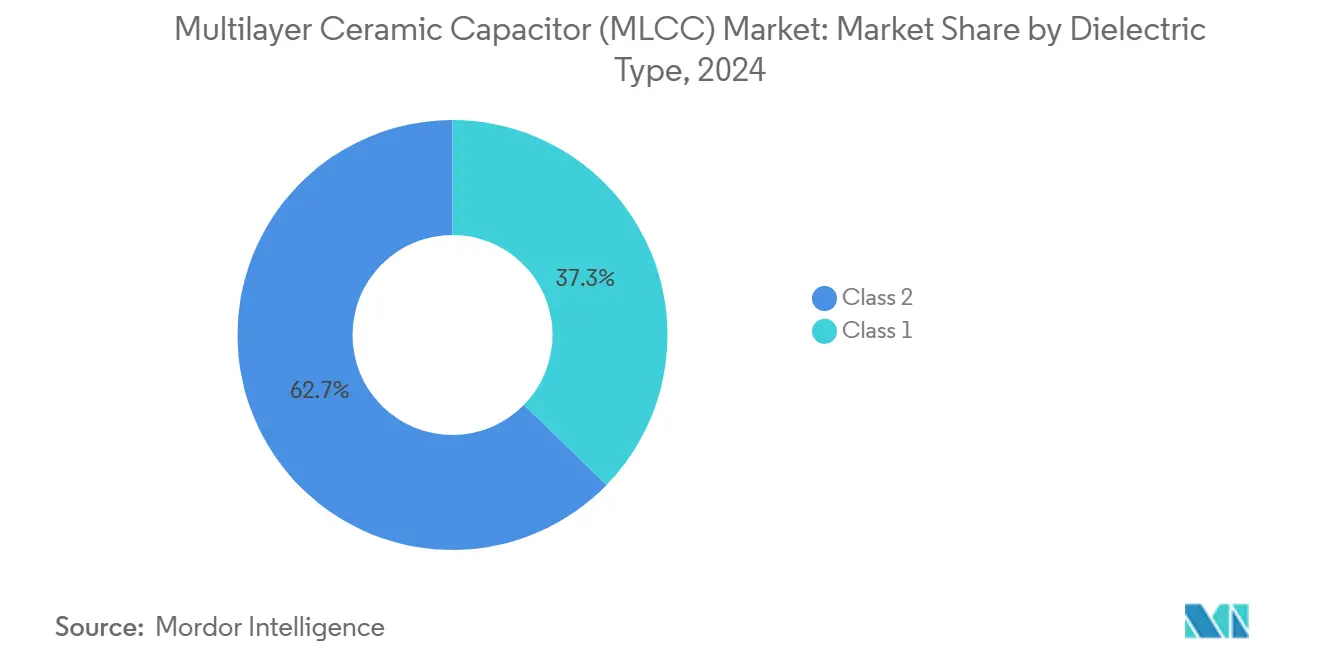
By Case Size: 201 Fastest Growing, 402 Still Sweet-Spot
The mature 201 outline retained 56.48% unit share in 2024 thanks to its favorable balance of manufacturing yield and 10-µF headroom. Yet the 402 footprint is sprinting ahead at 18.66% CAGR as handset OEMs shave z-height. Kyocera’s 10 µF 0201 prototype redefines density limits, though 0201 adoption remains niche until assembly yields stabilize.
Scaling down exacerbates dielectric-layer crack risk, driving investments in soft-termination and polymer barrier layers. For power-train DC-link arrays, designers still select 1210 or even 2220 outlines where thermal mass and ripple current handling outweigh board real estate, preserving high-voltage reliability within the multilayer ceramic capacitor market.
By Voltage Rating: Mid Range Niche Expands Rapidly
Low-Range Voltage segments covered 59.34% of 2024 demand, spanning virtually every consumer gadget and telecom blade. The Mid-Range Voltage tier equips industrial automation and 48 V mild-hybrid cars. Mid-Range Voltage, growth accelerates at 17.55% CAGR as 800 V EV batteries and renewable inverters standardize higher bus voltages. Vishay’s 3,000 V C0G launch testifies to a frontier that now approaches film-capacitor domains while shrinking footprint by 70%.
Cost remains elevated because higher voltages require thicker dielectrics, lower layer counts per part, and longer sintering cycles, but automotive OEMs accept premiums to meet creepage and derating mandates. Thus, premium ASPs cushion margin compression elsewhere in the multilayer ceramic capacitor market share mix.
By Mounting Type: Surface-Mount Rules, Metal-Cap Gains Traction
Surface-mount devices held a 41.70% share in 2024 and remain standard across SMT lines. Metal-cap variants, however, grow 18.34% CAGR for applications plagued by board flex, such as EV traction boards and industrial drives. Soft-termination chemistries with polymer buffers add compliance, cutting micro-crack fallout in AEC-Q200 flex tests.
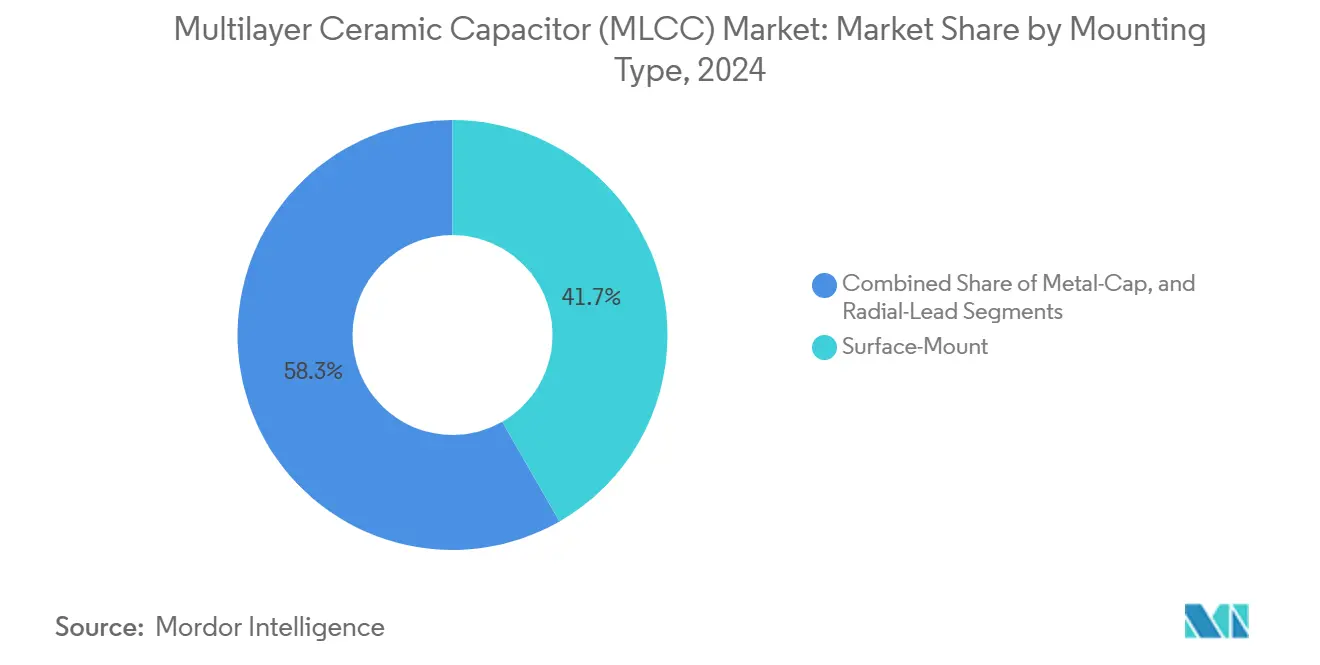
Note: Segment shares of all individual segments available upon report purchase
By End User: Automotive Surpasses Consumer Growth Rates
Consumer electronics absorbed 51.46% of shipments in 2024, but auto rises fastest at 30.06% CAGR as inverter voltages ratchet higher and ADAS domain controllers multiply. Industrial and telecom follow, each chasing high-capacitance, high-voltage arrays. Medical and defense remain small-volume yet attractive-margin niches demanding zero-defect quality and lot traceability.
Geography Analysis
Asia-Pacific captured 57.69% of 2024 revenue, anchored by Japan’s materials mastery, South Korea’s handset pipeline, and China’s cost-optimized mass production. Leading Japanese suppliers Murata, TDK, and Taiyo Yuden collectively own a major share of global MLCC furnace capacity, safeguarding process know-how that newcomers struggle to replicate. Regional proximity to EMS hubs shortens cash cycles and supports just-in-time delivery to smartphone, PC, and white-goods lines.
North America is the fastest riser at 19.53% CAGR through 2030. North America and Europe form a mature demand block tied to EV rollouts, datacenter expansions, and semiconductor reshoring. U.S. CHIPS Act subsidies underwrite pilot MLCC lines, though scaling to parity with Asian incumbents will take years. European automakers co-develop high-voltage C0G arrays to streamline traction inverter design and swap bulky film capacitors with lighter MLCC banks, reflecting a clear premium-technology pull.
Gulf states bankroll smart-city and renewable-energy megaprojects that need high-reliability power-conditioning capacitors, while African EMS clusters in Egypt and Kenya source cost-competitive Class 2 parts for local handset assembly. Ongoing diversification away from hydrocarbons is steadily enlarging the regional multilayer ceramic capacitor market.
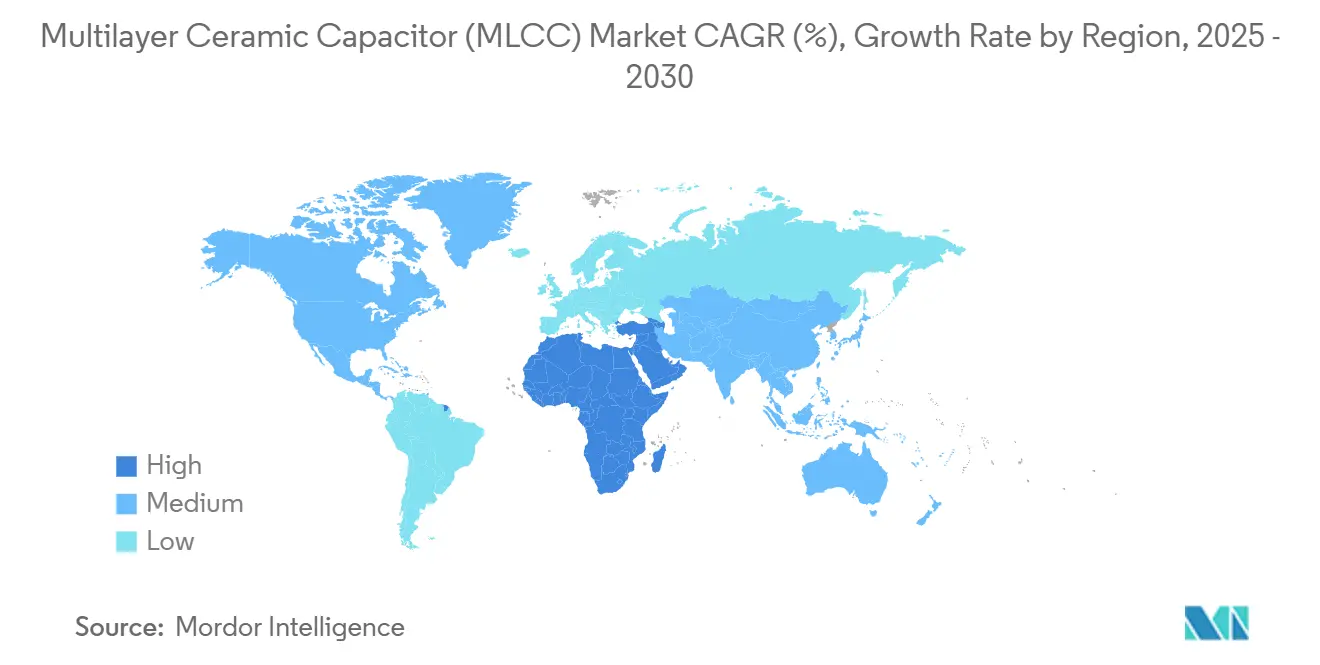
Competitive Landscape
High concentration defines the multilayer ceramic capacitor market: Murata, TDK, and Taiyo Yuden together hold roughly major share of installed global capacity, creating an oligopoly with strong pricing power in specialty grades. Their moat arises from captive dielectric powder synthesis, proprietary multilayer printing, and in-house termination paste formulations that set steep entry hurdles for latecomers.
Samsung Electro-Mechanics leverages vertical alignment with smartphone and automotive electronics arms to carve premium niches, such as the first LiDAR-optimized MLCC that pairs 2.2 µF with 10 V rating in a 1005 footprint. Fast-growing Chinese vendors, notably Yageo and Walsin, attack price-sensitive automotive infotainment and industrial projects, but still trail in high-voltage yields and C0G precision lines.
Strategic activity centers on capacity adds for automotive and high-CV parts. TDK’s Kitakami plant focuses on 1,250 V C0G and 100 V, 10 µF X7R devices, while Murata expands Tamil Nadu output to hedge geopolitical risk and tap Indian EV growth. Alternative technologies, silicon capacitors and NanoLam polymer hybrids, gain footholds in niche power modules but are yet to pose a broad threat to the multilayer ceramic capacitor industry incumbents.
Multilayer Ceramic Capacitor (MLCC) Industry Leaders
-
Murata Manufacturing Co., Ltd.
-
Samsung Electro-Mechanics Co., Ltd.
-
Taiyo Yuden Co., Ltd.
-
Yageo Corporation
-
TDK Corporation
- *Disclaimer: Major Players sorted in no particular order
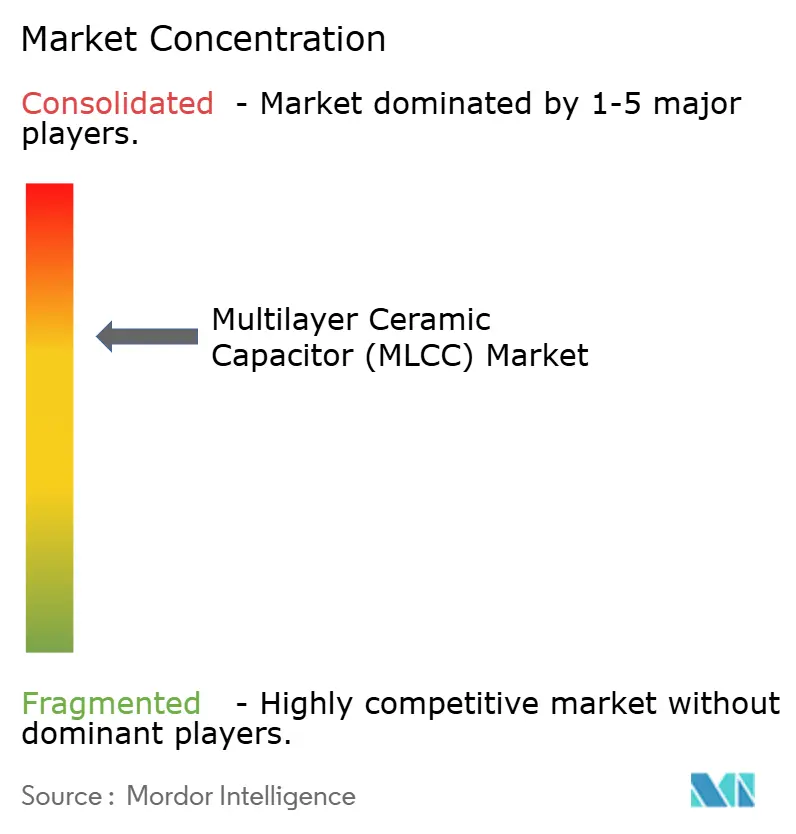
Recent Industry Developments
- April 2025: TDK rolled out 100 V, 10 µF automotive MLCCs in 3225 case size, halving board area for 48 V subsystems.
- February 2025: Vishay launched commercial MLCCs rated up to 3,000 V across seven case sizes.
- February 2025: Samsung Electro-Mechanics released a 2.2 µF, 10 V LiDAR-grade MLCC in 1005 size with AEC-Q200 certification.
- January 2025: TDK introduced a 10 nF, 1,250 V C0G MLCC in 3225 size for SiC-MOSFET EV inverters.
Global Multilayer Ceramic Capacitor (MLCC) Market Report Scope
Class 1, Class 2 are covered as segments by Dielectric Type. 0 201, 0 402, 0 603, 1 005, 1 210, Others are covered as segments by Case Size. High-Range Voltage (More than 1000V), Low-Range Voltage (Less than 500V), Mid-Range Voltage (500V to 1000V) are covered as segments by Voltage. High-Range Capacitance (More than 1000µF), Low-Range Capacitance (Less than 100µF), Mid-Range Capacitance (100µF to 1000µF) are covered as segments by Capacitance. Metal Cap, Radial Lead, Surface Mount are covered as segments by Mlcc Mounting Type. Aerospace and Defence, Automotive, Consumer Electronics, Industrial, Medical Devices, Power and Utilities, Telecommunication, Others are covered as segments by End User. Asia-Pacific, Europe, North America are covered as segments by Region.| Class 1 |
| Class 2 |
| 201 |
| 402 |
| 603 |
| 1005 |
| 1210 |
| Other Case Sizes |
| Low Voltage (less than or equal to 100 V) |
| Mid Voltage (100 - 500 V) |
| High Voltage (above 500 V) |
| Surface-Mount |
| Metal-Cap |
| Radial-Lead |
| Aerospace and Defence |
| Automotive |
| Consumer Electronics |
| Industrial |
| Medical Devices |
| Power and Utilities |
| Telecommunication |
| Other End User Applications |
| North America | United States |
| Rest of North America | |
| Europe | Germany |
| United Kingdom | |
| Rest of Europe | |
| Asia-Pacific | China |
| Japan | |
| South Korea | |
| India | |
| Rest of Asia-Pacific | |
| Rest of the World |
| By Dielectric Type | Class 1 | |
| Class 2 | ||
| By Case Size | 201 | |
| 402 | ||
| 603 | ||
| 1005 | ||
| 1210 | ||
| Other Case Sizes | ||
| By Voltage Rating | Low Voltage (less than or equal to 100 V) | |
| Mid Voltage (100 - 500 V) | ||
| High Voltage (above 500 V) | ||
| By Mounting Type | Surface-Mount | |
| Metal-Cap | ||
| Radial-Lead | ||
| By End User Application | Aerospace and Defence | |
| Automotive | ||
| Consumer Electronics | ||
| Industrial | ||
| Medical Devices | ||
| Power and Utilities | ||
| Telecommunication | ||
| Other End User Applications | ||
| By Geography | North America | United States |
| Rest of North America | ||
| Europe | Germany | |
| United Kingdom | ||
| Rest of Europe | ||
| Asia-Pacific | China | |
| Japan | ||
| South Korea | ||
| India | ||
| Rest of Asia-Pacific | ||
| Rest of the World | ||
Market Definition
- MLCC (Multilayer Ceramic Capacitor) - A type of capacitor that consists of multiple layers of ceramic material, alternating with conductive layers, used for energy storage and filtering in electronic circuits.
- Voltage - The maximum voltage that a capacitor can safely withstand without experiencing breakdown or failure. It is typically expressed in volts (V)
- Capacitance - The measure of a capacitor's ability to store electrical charge, expressed in farads (F). It determines the amount of energy that can be stored in the capacitor
- Case Size - The physical dimensions of an MLCC, typically expressed in codes or millimeters, indicating its length, width, and height
| Keyword | Definition |
|---|---|
| MLCC (Multilayer Ceramic Capacitor) | A type of capacitor that consists of multiple layers of ceramic material, alternating with conductive layers, used for energy storage and filtering in electronic circuits. |
| Capacitance | The measure of a capacitor's ability to store electrical charge, expressed in farads (F). It determines the amount of energy that can be stored in the capacitor |
| Voltage Rating | The maximum voltage that a capacitor can safely withstand without experiencing breakdown or failure. It is typically expressed in volts (V) |
| ESR (Equivalent Series Resistance) | The total resistance of a capacitor, including its internal resistance and parasitic resistances. It affects the capacitor's ability to filter high-frequency noise and maintain stability in a circuit. |
| Dielectric Material | The insulating material used between the conductive layers of a capacitor. In MLCCs, commonly used dielectric materials include ceramic materials like barium titanate and ferroelectric materials |
| SMT (Surface Mount Technology) | A method of electronic component assembly that involves mounting components directly onto the surface of a printed circuit board (PCB) instead of through-hole mounting. |
| Solderability | The ability of a component, such as an MLCC, to form a reliable and durable solder joint when subjected to soldering processes. Good solderability is crucial for proper assembly and functionality of MLCCs on PCBs. |
| RoHS (Restriction of Hazardous Substances) | A directive that restricts the use of certain hazardous materials, such as lead, mercury, and cadmium, in electrical and electronic equipment. Compliance with RoHS is essential for automotive MLCCs due to environmental regulations |
| Case Size | The physical dimensions of an MLCC, typically expressed in codes or millimeters, indicating its length, width, and height |
| Flex Cracking | A phenomenon where MLCCs can develop cracks or fractures due to mechanical stress caused by bending or flexing of the PCB. Flex cracking can lead to electrical failures and should be avoided during PCB assembly and handling. |
| Aging | MLCCs can experience changes in their electrical properties over time due to factors like temperature, humidity, and applied voltage. Aging refers to the gradual alteration of MLCC characteristics, which can impact the performance of electronic circuits. |
| ASPs (Average Selling Prices) | The average price at which MLCCs are sold in the market, expressed in USD million. It reflects the average price per unit |
| Voltage | The electrical potential difference across an MLCC, often categorized into low-range voltage, mid-range voltage, and high-range voltage, indicating different voltage levels |
| MLCC RoHS Compliance | Compliance with the Restriction of Hazardous Substances (RoHS) directive, which restricts the use of certain hazardous substances, such as lead, mercury, cadmium, and others, in the manufacturing of MLCCs, promoting environmental protection and safety |
| Mounting Type | The method used to attach MLCCs to a circuit board, such as surface mount, metal cap, and radial lead, which indicates the different mounting configurations |
| Dielectric Type | The type of dielectric material used in MLCCs, often categorized into Class 1 and Class 2, representing different dielectric characteristics and performance |
| Low-Range Voltage | MLCCs designed for applications that require lower voltage levels, typically in the low voltage range |
| Mid-Range Voltage | MLCCs designed for applications that require moderate voltage levels, typically in the middle range of voltage requirements |
| High-Range Voltage | MLCCs designed for applications that require higher voltage levels, typically in the high voltage range |
| Low-Range Capacitance | MLCCs with lower capacitance values, suitable for applications that require smaller energy storage |
| Mid-Range Capacitance | MLCCs with moderate capacitance values, suitable for applications that require intermediate energy storage |
| High-Range Capacitance | MLCCs with higher capacitance values, suitable for applications that require larger energy storage |
| Surface Mount | MLCCs designed for direct surface mounting onto a printed circuit board (PCB), allowing for efficient space utilization and automated assembly |
| Class 1 Dielectric | MLCCs with Class 1 dielectric material, characterized by a high level of stability, low dissipation factor, and low capacitance change over temperature. They are suitable for applications requiring precise capacitance values and stability |
| Class 2 Dielectric | MLCCs with Class 2 dielectric material, characterized by a high capacitance value, high volumetric efficiency, and moderate stability. They are suitable for applications that require higher capacitance values and are less sensitive to capacitance changes over temperature |
| RF (Radio Frequency) | It refers to the range of electromagnetic frequencies used in wireless communication and other applications, typically from 3 kHz to 300 GHz, enabling the transmission and reception of radio signals for various wireless devices and systems. |
| Metal Cap | A protective metal cover used in certain MLCCs (Multilayer Ceramic Capacitors) to enhance durability and shield against external factors like moisture and mechanical stress |
| Radial Lead | A terminal configuration in specific MLCCs where electrical leads extend radially from the ceramic body, facilitating easy insertion and soldering in through-hole mounting applications. |
| Temperature Stability | The ability of MLCCs to maintain their capacitance values and performance characteristics across a range of temperatures, ensuring reliable operation in varying environmental conditions. |
| Low ESR (Equivalent Series Resistance) | MLCCs with low ESR values have minimal resistance to the flow of AC signals, allowing for efficient energy transfer and reduced power losses in high-frequency applications. |
Research Methodology
Mordor Intelligence has followed the following methodology in all our MLCC reports.
- Step 1: Identify Data Points: In this step, we identified key data points crucial for comprehending the MLCC market. This included historical and current production figures, as well as critical device metrics such as attachment rate, sales, production volume, and average selling price. Additionally, we estimated future production volumes and attachment rates for MLCCs in each device category. Lead times were also determined, aiding in forecasting market dynamics by understanding the time required for production and delivery, thereby enhancing the accuracy of our projections.
- Step 2: Identify Key Variables: In this step, we focused on identifying crucial variables essential for constructing a robust forecasting model for the MLCC market. These variables include lead times, trends in raw material prices used in MLCC manufacturing, automotive sales data, consumer electronics sales figures, and electric vehicle (EV) sales statistics. Through an iterative process, we determined the necessary variables for accurate market forecasting and proceeded to develop the forecasting model based on these identified variables.
- Step 3: Build a Market Model: In this step, we utilized production data and key industry trend variables, such as average pricing, attachment rate, and forecasted production data, to construct a comprehensive market estimation model. By integrating these critical variables, we developed a robust framework for accurately forecasting market trends and dynamics, thereby facilitating informed decision-making within the MLCC market landscape.
- Step 4: Validate and Finalize: In this crucial step, all market numbers and variables derived through an internal mathematical model were validated through an extensive network of primary research experts from all the markets studied. The respondents are selected across levels and functions to generate a holistic picture of the market studied.
- Step 5: Research Outputs: Syndicated Reports, Custom Consulting Assignments, Databases, and Subscription Platform
